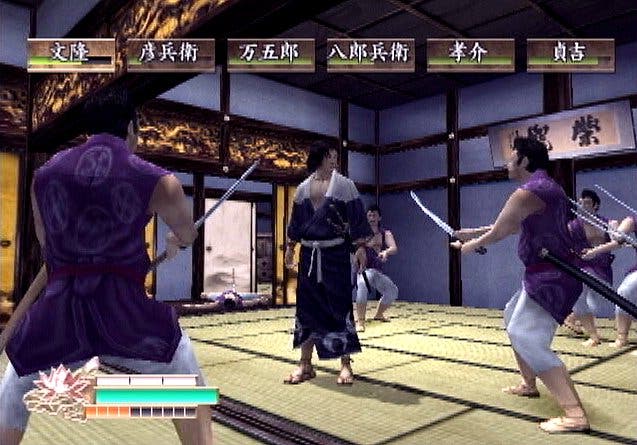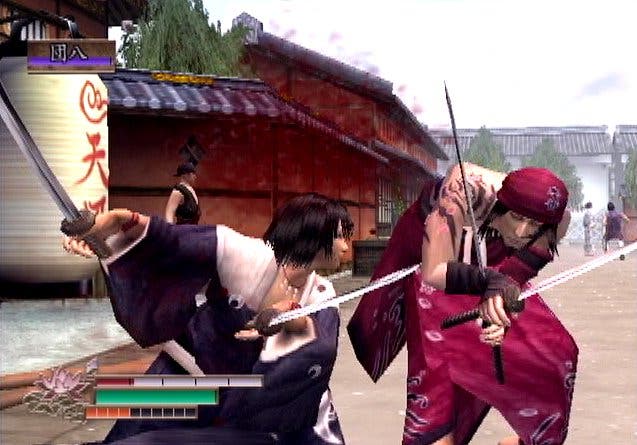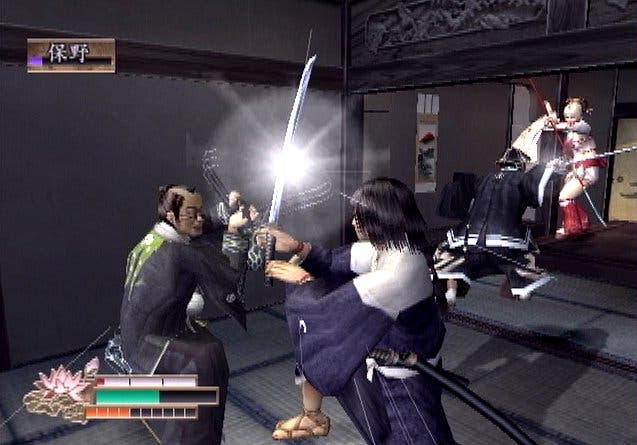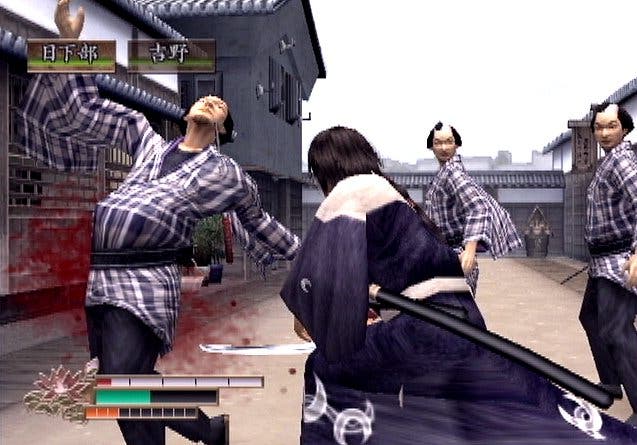Way of the Samurai 2
Fancy a short, neatly packaged adventure that lets you pick a new path every time you play it? Then buy the first Way of the Samurai. This one we're not so sure about.
Shop for games now with Simply Games.
Remember the days when, every time you fired up your favourite game, you had to start right from the beginning? Remember that same, tired, first handful of levels that you'd seen hundreds of times before? Remember the peaks and troughs along the way to the new stuff? Remember the inevitability of dying at least once or twice performing a really simple task, because your mind was already thinking half an hour ahead? That's roughly what it's like to play Way of the Samurai 2 beyond your first go. Assuming you'll accept "about playing something else" as a substitute for "half an hour ahead".
That's The Way

Except, in the case of Acquire's latest - distributed by Capcom over here - the trade-off for the tedium of having to start over each time is meant to be the element of choice. The idea is that you - a wandering ronin with no particular place to go or task to perform - have stumbled into the feudal Japanese town of Amahara, where you will spend ten days in whatever manner you see fit. You can help or hinder the people you meet, side with the goodies, join the local gang, or just cause mischief until your time is up - either after ten days, when you'll see one of the game's endings, or sooner, should you happen to die beforehand for whatever reason.
It's more or less the same approach that the original Way of the Samurai took, except that where that game - released in Europe on Eidos' ill-fated 'Fresh Games' label - managed to contribute a fairly interesting and compressed little yarn, quirky characters and tricky combat, WotS2 is neither interesting nor challenging, and the choices it lets you make are neither here nor there. It's also horrifically badly voiced, visually archaic and painfully scripted and contrived. In short, it's not very good. In fact, here's a better one: it's short and it's not very good.
So where did it all go wrong? Well, first of all, there's the question of whether it was all right to begin with. The original was certainly rife with problems, although in general we gave them the benefit of the doubt because we enjoyed the experience overall. But while WotS2 builds on what went before, it seems to have inherited the problems that afflicted the first game wholesale, developed its own niggles, and padded out the rest of the disc with other elements that fail to capture our interest.
Not The Way

The biggest problem initially is that helping people is just not entertaining. The game is relatively freeform once you land in Amahara - you arrive dishevelled and starving, and a little mute girl (lovingly referred to as "No-name from Amakaze" by her friends and acquaintances) gives you a rice ball to perk you up. Immediately afterward you're faced with the choice of helping her, or not - rather like the first game, when you were thrust into the middle of an altercation on a bridge - and the obvious choice is to take on the ruffians antagonising her in the street. After all, she's weak and helpless, and they're unkempt brutes dressed like clowns who talk nonsense and sound like Barney Rubble. (Really.)
Doing this though is seriously ill-advised, because the path of good - helping her, getting to know her friends, agreeing to teach her to read and write - leads you towards a series of ridiculously mundane fetch quest style tasks, and forces you to treat everyone like gold. You can of course opt not to help her, but eventually you'll be forced to pick a side of the town's politics - siding with the rather unpleasant Aoto Gang, helping the Magistrates who are out to police the place back to peace, or joining the townspeople's cause and trying to right things that way.
Whatever your choice, you'll soon wind up with a small room of a home where you return to recuperate at the end of a day or should your health take a serious walloping (which is, in fairness, a clever idea - giving you the option of sacrificing a certain amount of time for a certain amount of healing), and a number of relatively enclosed locations around town that you can visit at any time of night or day to rendezvous with various characters and try and drag the story in a particular direction - usually by following someone's instructions and kicking off a scripted sequence as a result.
And whatever path you follow, you'll soon find your time is up in Amahara. The average game lasts several hours, and there are some 14 endings to unlock depending on how you approach every situation. But annoyingly there's no real impetus to keep coming back, because whichever way you play it, the characters you meet lack, well, character, the dialogue is mediocre and the voice acting brittle and forced, and the entire story - despite its brevity - is hardly cohesive. That's something we felt the first game had, and one of the reasons we were tempted to revisit it and play it out in a different manner. Unlocking new costumes is hardly the same calibre of incentive.
Killing Time

The lack of challenge is another issue. Although the developer understandably wants to avoid your having to restart any more than necessary, the tactics employed here don't really work. In the first game, combat was no cakewalk, but it wasn't massively frustrating either - it actually relied to a large extent on your own dedication to it, because you'd only develop a well-rounded repertoire of attacks if you actually bothered to do more than mash the square button continuously.
Making an effort to do more than just the basic attack gave you the edge in battle, and helped keep things relatively fresh. And while that's still true of the sequel, new techniques like an instant kill attack strip out a lot of the graft, and the AI is woeful enough - circling and waiting to be slashed, for the most part - that you rarely have to worry about branching out. As for visiting the blacksmith for upgrades and new swords - you can, but it's not something you need to worry about very often.
And that's largely what's wrong with Way of the Samurai 2 - there's a lot of choice, which is good, but the game doesn't actually give you anything you particularly want to do. To give you an example, early on when you're being coveted by various groups, you may visit the Aoto Gang and meet their leader, and he'll happily spill his guts to you about his grand plan. Tell him to stuff it though, and he'll just merrily let you march away, off to go and side with the Magistrates. Except, for some bizarre reason, you're in no position to actually tell them about the Aoto plan - instead, you're just privy to whatever they're thinking and given the option to pick a comment every now and then out of a choice of three or four.
Blade Dry

At this point you're left to consider the things you can actually choose to do, and none of them is particularly engaging. Missions, which you'll have to take up from one party or other to pay your way, are pretty tedious - rescuing kidnapped babies is just not something we seem to enjoy - and talking to the townsfolk is only entertaining if there's somebody around to join in with your mockery. There's almost no suspension of disbelief whatsoever, and although the developer tries to have some fun with this, it doesn't work. NPCs (who will sometimes just appear out of thin air, incidentally) will stand there waiting to spout the most inane rubbish you've ever heard. "Shall I expound on the importance of getting proper rest at home?" says one after you happen up to him.
Even the main characters - the ones voiced over in cut-scenes - have an annoying American accent that just shatters the whole illusion, and they sound like they're talking to you through a king hangover mixed with a few pints of disinterest. And the attempts at humour include what we think is a fart joke at one point, which is surely worth a few docked marks.
Most telling of all though is a point early on where a chap called Danpachi says, "What brings you to Amahara? You don't seem to have anything in particular to do." It's true, see, and while that approach worked to a certain extent in the original, the mishmash of badly written characters, loose plot threads, uninspired combat and mission design and the infectious sense of disinterest on display here stand little chance of following in its footsteps. It's not an unpleasant experience to play - you rarely feel lost or uncertain of how to make progress, and there have been far worse games released this year - but nevertheless, if there is to be a third Way of the Samurai, we'd recommend the developer seriously consider starting from the beginning again.

